GR®70 From Pradelles to La Bastide-Puylaurent |
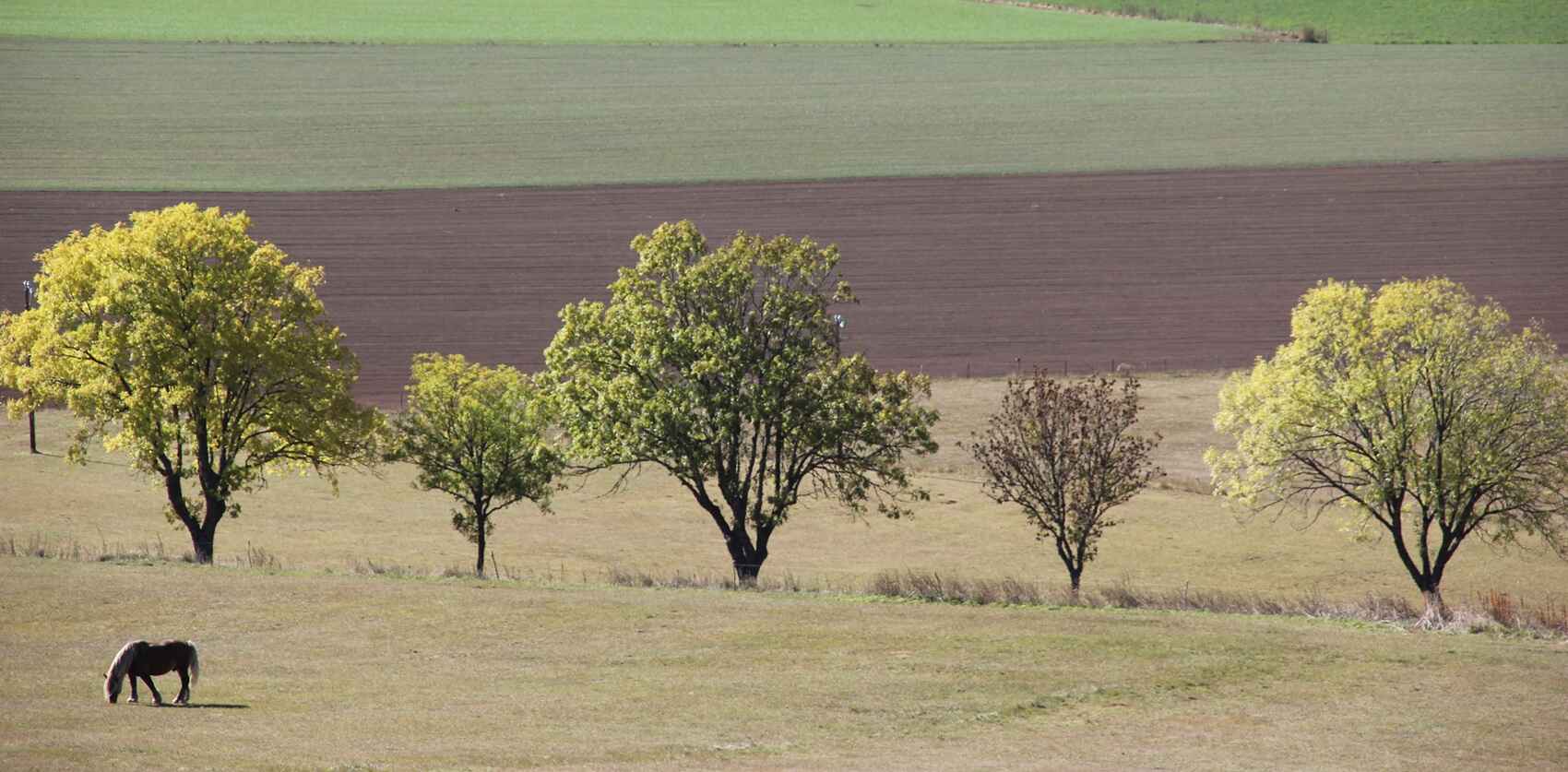
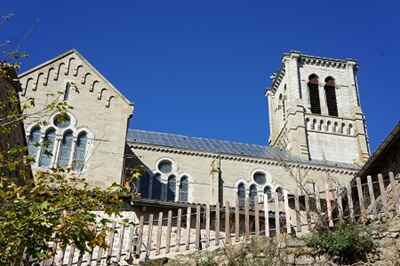 On the morning of the third day, we discover a gray and cold sky, only two degrees, and the few drops from the sky, hesitant in their weeping, seem thick; snow doesn't seem far away. This is our wake-up call as we ascend the streets of Pradelles towards the café.
On the morning of the third day, we discover a gray and cold sky, only two degrees, and the few drops from the sky, hesitant in their weeping, seem thick; snow doesn't seem far away. This is our wake-up call as we ascend the streets of Pradelles towards the café.
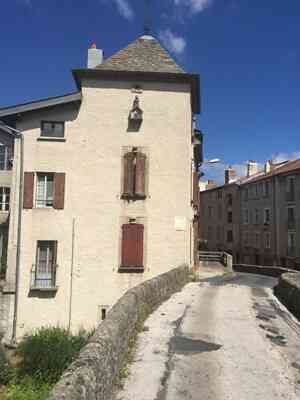 Descending between the stone houses amid the smell of a bakery brings me back to village life a few decades ago; now, the deserted alleys, despite their excellent maintenance, sadly display an impressive number of "For Sale" signs.
Descending between the stone houses amid the smell of a bakery brings me back to village life a few decades ago; now, the deserted alleys, despite their excellent maintenance, sadly display an impressive number of "For Sale" signs.
Langogne is not far; a path leads down to it quietly before joining the main road at the bridge where the departments of Haute-Loire, Ardèche, and Lozère converge. Mende, its prefecture, is one of the smallest in France, but its wild and deserted landscapes, neighboring Aveyron, speak to independent spirits, and my brother and I have been greatly guided by them on this journey.
For now, the situation is rather strange; we advance between cars and shop windows. This boulevard once had a different age with ramparts instead of asphalt. Meanwhile, Pierre, in search of an original language version, being a former English teacher, heads to the bookstore while other lost members of the group linger in cafés or bakeries.
We leave the relatively tumultuous city through a charming old narrow and arched bridge. A bit of asphalt still leads us towards the paths and the last fields. The sky is gray over the plowed land, and the Scots pines add their dark green tops and salmon trunks to the scene. They are becoming increasingly numerous.
In Saint-Flour-de-Mercoire, Saint Roch watches over the crossroads near the communal oven and the washhouse. The church is hidden away. We find refuge under the roof of the washhouse to have a picnic. In this small village, there is a theater association that has caught the interest of our actor friend; a note on the door and the traces of iron hooves belonging to his large gray donkey confirm his presence before us. The Belgians are also here, having arrived by car for a piece on foot, and Pierre, the photographer, overtakes us and waits for a few shots as we resume our march.
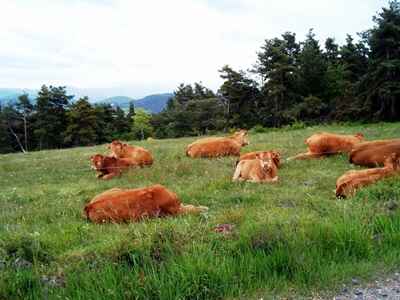 Fouzillic and Fouzillac marked Stevenson's journey as places of bewilderment and inhospitability. Today, the fog also floods the heath between pines and broom; the path gets lost among the tall grasses and marshes, bringing closer the troubled souls evoked by Stevenson in his wandering.
Fouzillic and Fouzillac marked Stevenson's journey as places of bewilderment and inhospitability. Today, the fog also floods the heath between pines and broom; the path gets lost among the tall grasses and marshes, bringing closer the troubled souls evoked by Stevenson in his wandering.
The approach to Cheylard-l'Evêque is hastened by the rain. The Refuge du Moure, where we quickly seek shelter from the cold and wet, welcomes us tonight. The hostess is friendly, and the dining room, decorated in wood, is warm with jars of jam and homemade creations on shelves, a bar in one corner, and photographic escapes to Antarctica on the walls.
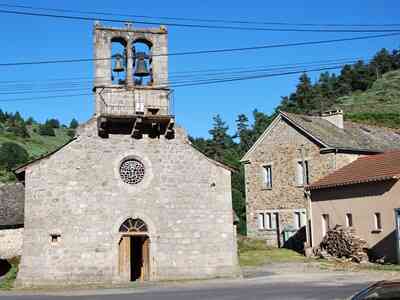 Pierre, the photographer, dines with us and a few brave souls, not too exhausted, hasten the end of the meal to go see the reworked and corrected "Voyage of Stevenson" in a theater play. Indeed, we have joined a genuine stopping place of the Scottish writer, and thus, the actor we met performs here tonight. The performance of the solitary actor and the audiovisual techniques of his companions is interesting, especially appreciated in the context of this small village lost in the rain. The directed reading of the original work will lead us to some exchanges of viewpoints and perceptions the next day. A shared drink offered by the municipality concludes the evening. And gently, we slip into our darkened rooms.
Pierre, the photographer, dines with us and a few brave souls, not too exhausted, hasten the end of the meal to go see the reworked and corrected "Voyage of Stevenson" in a theater play. Indeed, we have joined a genuine stopping place of the Scottish writer, and thus, the actor we met performs here tonight. The performance of the solitary actor and the audiovisual techniques of his companions is interesting, especially appreciated in the context of this small village lost in the rain. The directed reading of the original work will lead us to some exchanges of viewpoints and perceptions the next day. A shared drink offered by the municipality concludes the evening. And gently, we slip into our darkened rooms.
A truly complete breakfast with everything anyone could wish for is set up as self-service to kickstart the day with energy, especially since the rain has cleared, allowing us to discover the village of Cheylard-l'Evêque today. The chapel overlooking the village remains in the background above the treetops lining the path. This building, like the name of the village, is due to the ancient presence of the holiday residence of the bishops of Mende here.
The itinerary passes through pine forests, lush green valleys bordering streams, and higher paths overlooking wooded hills, with few houses. The group has split; the vanguard moves quickly while searching for mushrooms, while behind, we are three "lingering".
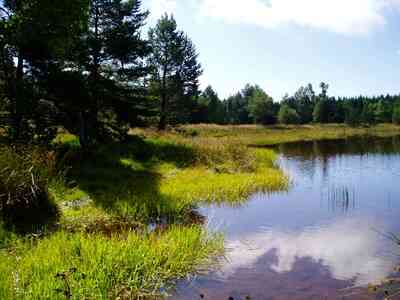 A shelter at the edge of a lake motivated the others to wait for us; it's not that warm. Exchanges occur among the drivers, and off we go to the castle of Luc. Laurent, transported that day in the technicians' van due to a tendonitis, arrives to meet us, a happy sign of the midday objective. In the heart of the ruins, a cool wind blows despite the sun, and everyone sets off in their own direction, curiously exploring traces of the past or intrigued by the protective walls.
A shelter at the edge of a lake motivated the others to wait for us; it's not that warm. Exchanges occur among the drivers, and off we go to the castle of Luc. Laurent, transported that day in the technicians' van due to a tendonitis, arrives to meet us, a happy sign of the midday objective. In the heart of the ruins, a cool wind blows despite the sun, and everyone sets off in their own direction, curiously exploring traces of the past or intrigued by the protective walls.
Christophe, the solitary actor, joins the steps of the last among us for the descent into the village, an opportunity to extend the dialogue from the previous day and to bring Stevenson and different perspectives on his journey back to life. Unfortunately, we will not see each other again this time as the author made a stop in Luc; the theater troupe stays there while we head for La Bastide-Puylaurent that same evening via the Abbey of Notre-Dame des Neiges.
In Luc, a barn catches the attention of Pierre, Denis, and me separately, and it will be imprinted on the film of our respective cameras without any prior consultation. Its appearance, with the arrangement of its stones, attracts the eye, which is confirmed by the date on the door, predating 1700.
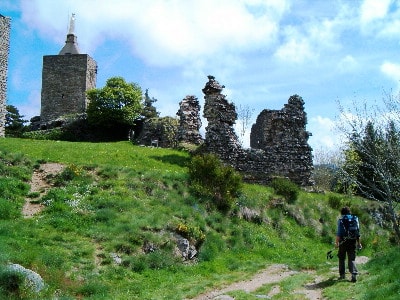 The first part of the afternoon is the opposite of the morning; between road and train, the journey seems closer to civilization and is certainly more frequented. Nevertheless, large abandoned colony buildings, at least we hope so since their "barracks" appearance is somewhat frightening, testify to a retreat from human life even here along the communication routes. In any case, for us, distancing ourselves is best, and we ascend under the sun to the mountain that dominates the Abbey of Notre-Dame des Neiges. With the markers lost, we make our way by our own path, closer to Stevenson, who wandered without a strictly dictated route.
The first part of the afternoon is the opposite of the morning; between road and train, the journey seems closer to civilization and is certainly more frequented. Nevertheless, large abandoned colony buildings, at least we hope so since their "barracks" appearance is somewhat frightening, testify to a retreat from human life even here along the communication routes. In any case, for us, distancing ourselves is best, and we ascend under the sun to the mountain that dominates the Abbey of Notre-Dame des Neiges. With the markers lost, we make our way by our own path, closer to Stevenson, who wandered without a strictly dictated route.
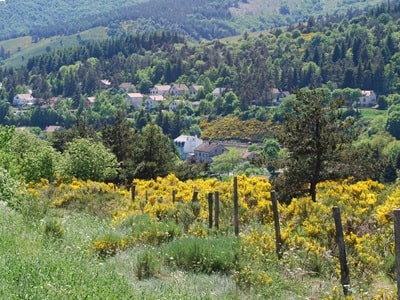 The view is wide towards La Bastide-Puylaurent and Mont Lozère, but the roofs of the monastery hide their tranquility behind the tall conifers until the last moment as we arrive from behind. I savor the calm of the place in the shade while some visit according to their tastes—the bookstore, the church, or the bar! These monks mature their own vintage here, coming from their vineyards in Gard (Bellegarde).
The view is wide towards La Bastide-Puylaurent and Mont Lozère, but the roofs of the monastery hide their tranquility behind the tall conifers until the last moment as we arrive from behind. I savor the calm of the place in the shade while some visit according to their tastes—the bookstore, the church, or the bar! These monks mature their own vintage here, coming from their vineyards in Gard (Bellegarde).
Denis, not feeling well, moves ahead alone while the others regroup for the last part of the day; it seems long, very long. A hiker comes towards us; it’s Pierre, the photographer; he plans to sleep like Stevenson with the monks, but it's not possible as the welcome is now intended for retreatants only.
At La Bastide-Puylaurent, despite a previous reconnaissance, I hesitate to find the Guesthouse L'Etoile, and then at last, we arrive at the home of Philippe Papadimitriou, this "friend" often mentioned by Christian, a prominent and appreciated member of our association. Is he as I had imagined? Yes and no, rather no; certainly not disappointing; and am I as I was on the phone?!
Our host has an unusual background, and his whole house reflects that. From the fireplace, through the piano in one corner, to the cep mushrooms picked that day cooked with garlic and herbs, to the shared meal and then Belgian beers, all the ingredients are there for a lively discussion between Denis and him; "What if we reinvented rural life?" Pierre reads by the fire, some have gone to bed, and we wonder what world we are in between past and present, terroir and universality, as the evening unfolds in this lovely little corner of Lozère connected to the world by a traveler host keen on the internet. by Catherine Revel
Former holiday hotel with a garden along the Allier, L'Etoile Guest House is located in La Bastide-Puylaurent between Lozere, Ardeche, and the Cevennes in the mountains of Southern France. At the crossroads of GR®7, GR®70 Stevenson Path, GR®72, GR®700 Regordane Way, GR®470 Allier River springs and gorges, GRP® Cevenol, Ardechoise Mountains, Margeride. Numerous loop trails for hiking and one-day biking excursions. Ideal for a relaxing and hiking getaway.
Copyright©etoile.fr